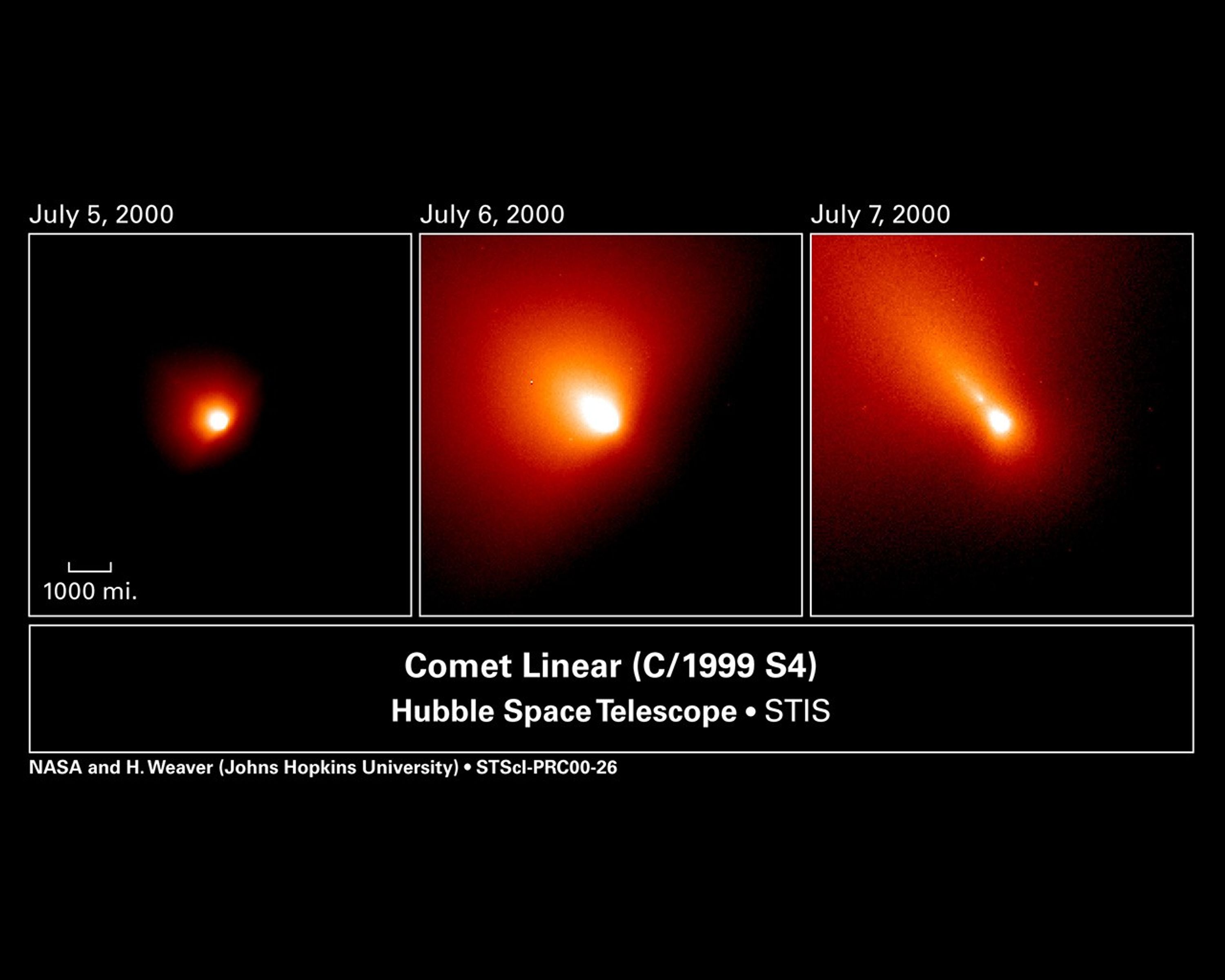1 min read
Comet LINEAR’s Violent Outburst

These three photographs taken with NASA's Hubble Space Telescope chronicle a violent outburst in the life of comet LINEAR, also known as C/1999 S4. The orbiting observatory's Space Telescope Imaging Spectrograph tracked the streaking comet for two days, July 5 to 7, capturing a dramatic leap in its brightness [left image]; followed by seeing a wave of newly created dust from the outburst flowing into the coma, a shell of dust surrounding the core [middle image]; and culminating in the discovery of a castoff chunk of material from the nucleus sailing along its tail [the bright dot trailing behind the comet in the picture at right]. The white region represents the brightest part of the coma. The nucleus cannot be seen in these images because it is about a mile or so across, which is too small for the Hubble telescope to see.
When the Hubble telescope snapped these visible-light images, comet LINEAR was 74 million miles (120 million km) from Earth. At 6:32 p.m. EDT July 5 [left image], Hubble watched as the light within a 50-mile-wide region surrounding the core brightened by about 50 percent in less than four hours. By 5:20 p.m. EDT the next day [middle image], that region was a third less luminous than at its peak the previous day, as the dust expelled from the core during the outburst moved farther out in the coma. By 7:04 p.m. EDT on the final day [right image], the comet's brightness was back to normal – about one-seventh less luminous than at peak level.
The chunk of material seen in the final picture is roughly 290 miles (470 km) from the nucleus and appears to be moving down the tail at about 6 miles per hour. The fragment's slow pace indicates that it could be quite large (possibly house-size), but accurate estimates for the sizes of the chunk and of the core require further analyses of the Hubble images and data from other observatories.
About the Object
- DistanceDistanceThe physical distance from Earth to the astronomical object. Distances within our solar system are usually measured in Astronomical Units (AU). Distances between stars are usually measured in light-years. Interstellar distances can also be measured in parsecs.On July 5, 2000 the comet was at a distance of 74 million miles (120 million km) from Earth.
About the Data
- Data DescriptionData DescriptionProposal: A description of the observations, their scientific justification, and the links to the data available in the science archive.
Science Team: The astronomers who planned the observations and analyzed the data. "PI" refers to the Principal Investigator.Principal Astronomers: Comet LINEAR investigation team: H. Weaver and P. Feldman (JHU), M. A'Hearn (Univ. of Maryland), C. Arpigny (Liege Univ.), J. Bauer (Univ. of Hawaii), M. Combi (Univ. of Michigan), J. Davies (Joint Astronomy Centre), M. Festou (Observatoire Midi-Pyrenees), M. Keesey (JPL), P. Lamy (Laboratoire d'Astronomie Spatiale), C. Lisse (STScI), B. Marsden (SAO), K. Meech (Univ. of Hawaii), Z. Sekanina (JPL) , I. Toth (Konkoly Observatory) , G.-P. Tozzi (Arcetri Observatory), D. Yeomans (JPL). - InstrumentInstrumentThe science instrument used to produce the data.HST>STIS
- Exposure DatesExposure DatesThe date(s) that the telescope made its observations and the total exposure time.July 5 - 7, 2000
- FiltersFiltersThe camera filters that were used in the science observations.F28X50LP
- Object NameObject NameA name or catalog number that astronomers use to identify an astronomical object.Comet LINEAR (Lincoln Laboratory Near-Earth Asteroid Research); C/1999 S4
- Object DescriptionObject DescriptionThe type of astronomical object.Comet
- Release DateJuly 28, 2000
- Science ReleaseHubble Sees Comet Linear Blow its Top
- CreditNASA, H. Weaver and P. Feldman (Johns Hopkins University), M. A'Hearn (University of Maryland), C. Arpigny (Liege University), M. Combi (University of Michigan), M. Festou (Observatoire Midi-Pyrenees), and G.-P. Tozzi (Arcetri Observatory)
Share
Details
Claire Andreoli
NASA’s Goddard Space Flight Center
Greenbelt, Maryland
claire.andreoli@nasa.gov

































